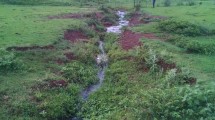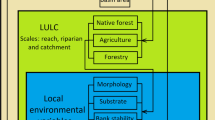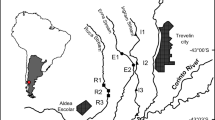Abstract
Riparian vegetation is one of the most important abiotic components determining the water flow pattern in lotic ecosystems, influencing the composition, richness, and diversity of invertebrates. We have identified whether differences in the structure of the assemblages of invertebrates between riffles and pools may influence the responses of fauna to the effects of land use. In addition, we investigated which fauna metrics are responsible for the differentiation between riffles and pools in streams subject to different land uses. During the dry season of 2012, the main substrates of riffles and pools were sampled (Surber collector) from nine streams within forest, pasture, and urban areas. Principal component analysis (PCA) and Permanova showed differences in the set of environmental variables between streams and mesohabitats. The first PCA axis distinguished the forest and pasture streams from the urban area streams and was related to variables indicative of nutrient enrichment and land use, while the second axis was formed by velocity flow and by the quantities of ultrafine and coarse sand, which distinguished the riffles and pools of the streams. The faunal composition distinguished the streams in pasture and forest areas from the urban streams. Riffles and pools were not concordant in the representation of the invertebrate fauna, indicating the importance of sampling both mesohabitats in the types of streams investigated. The richness, taxonomic composition, and relative abundance of families of Ephemeroptera, Plecoptera, and Trichoptera showed robust responses in riffles to the effects of environmental changes, while in pools, only the richness showed a significant response. It was possibly concluded that riffles were more sensitive in detecting the effects of land use. The information from this study help to understand how the community of invertebrates and the types of habitats in streams may be affected by anthropogenic impacts.






Similar content being viewed by others
References
ABNT - Associação Brasileira de Normas Técnicas (1982). Solo: análise granulométrica—NBR-7181 (p. 16). Rio de Janeiro.
Allan, J. D. (2004). Land uses and riverscapes: the influence of land use on stream ecosystems. Annual Review of Ecology, Evolution, and Systematics., 35, 257–284. doi:10.1146/annurev.ecolsys.35.120202.110122.
Allan, J. D., & Flecker, A. S. (1993). Biodiversity conservation in running waters. Bioscience, 43, 32–43.
Anderson, M. J. (2001). A new method for non-parametric multivariate analysis of variance. Austral Ecology, 26, 32–46.
Anderson, M. J., & ter Braak, C. J. F. (2003). Permutation tests for multi-factorial analysis of variance. Journal of Statistical Computation and Simulation, 73, 85–113.
APHA (1995). Standard methods (19th ed., ). Washington: American Public Health Association.
Baptista, D. F. (2008). Uso de macroinvertebrados em procedimentos de biomonitoramento em ecossistemas aquáticos. Oecologia Brasiliensis, 12, 425–441.
Barbour, M. T. (1997). The re-invention of biological assessment in the U.S. Human and Ecological Risk Assessment, 3(6), 933–940.
Barbour, M. T., Stribling, J. B., & Verdonschot, P. F. M. (2006). The multihabitat approach of USEPA’s rapid bioassessment protocols: benthic macroinvertebrates. Limnetica, 25(3), 839–850.
Bastos-Neto, O. J., Ribeiro de Oliviera, E. G., Mello, B. F., Amorim, T. O. S., Gomes, K. C. P., & Andriolo, A. (2009). Mamíferos de um fragmento florestal particular periurbano de juiz de fora, Minas Gerais, Brasil. Revista Brasileira de Zoociências, 11, 269–276.
Bispo, P. C., & Oliveira, L. G. (2007). Diversity and structure of Ephemeroptera, Plecoptera and Trichoptera (Insecta) assemblages from riffles in mountain streams of Central Brazil. Revista Brasileira de Zoologia, 24(2), 283–293.
Bonada, N., Rieradevall, M., Prat, N., & Resh, V. H. (2006). Benthic macroinvertebrate assemblages and macrohabitat connectivity in Mediterranean-climate streams of northern California. Journal of the North American Benthological Society, 25, 32–43. doi:10.2307/4095562.
Bonada, N., Rieradevall, M., & Prat, N. (2007). Macroinvertebrate community structure and biological traits related to flow permanence in a Mediterranean river network. Hydrobiologia, 589(1), 91–106.
Brown, A., & Brussock, P. (1991). Comparisons of benthic invertebrates between riffles and pools. Hydrobiologia, 220, 99–108. doi:10.1007/bf00006542.
Brown, H. P. (1987). Biology of riffle beetles. Annual Review of Entomology, 32, 253–273.
Buffagni, A., Erba, S., Cazzola, M., & Kemp, L. L. (2004). The AQEM multimetric system for the southern Italian Alpennines: assessing the impact of water quality & habitat degradation on pool macroinvertebrates in Mediterranean rivers. Hydrobiologia, 516, 313–329.
Carlson, P. E., Johnson, R. K., & McKie, B. G. (2013). Optimizing stream bioassessment: habitat, season, and the impacts of land use on benthic macroinvertebrates. Hydrobiologia, 704, 363–373.
Carvalho, A. L., & Calil, E. R. (2000). Chaves de identificação para as famílias de Odonata (Insecta) ocorrentes no Brasil, adultos e larvas. Papéis Avulsos de Zoologia, 41, 223–241.
Clarke, A., Mac Nally, R., Bond, N., & Lake, P. S. (2008). Macroinvertebrate diversity in headwater streams: a review. Freshwater Biology, 53, 1707–1721. doi:10.1111/j.1365-2427.2008.02041.x.
Crumpton, W. G., Isenhart, T. M., & Mitchell, P. D. (1992). Nitrate and organic N analyses with secondderivative spectroscopy. Limnology and Oceanography, 37(4), 907–913.
Cushing, C. E., & Allan, J. D. (2001). Streams: their ecology and life. California: Academic Press.
Dodds, W. K. (2002). 13—Nitrogen, sulfur, phosphorus, and other nutrients. In Freshwater ecology: concepts and applications (pp. 247–268). San Diego: Academic Press. doi:10.1016/B978-012219135-0/50014-3.
Domínguez, E., & Fernández, H. R. (2009). Macroinvertebrados bentónicos sudamericanos. Fundación Miguel Lillo, Tucumán: Sistemática y biología.
Frissell, C., Liss, W., Warren, C., & Hurley, M. (1986). A hierarchical framework for stream habitat classification: viewing streams in a watershed context. Environmental Management, 10, 199–214. doi:10.1007/bf01867358.
Gregory, S. V., Swanson, F. J., McKee, W. A., & Cummins, K. W. (1991). An ecosystem perspective of riparian zones. Bioscience, 41, 540–551. doi:10.2307/1311607.
Ghetti P.F. 1997. Manuale di applicazione Indice Biotico Esteso (I.B.E.). Trento: Provincia Autonoma di Trento, p 222.
Hepp, L. U., Milesi, S. V., Biasi, C., & Restello, R. M. (2010). Effects of agricultural and urban impacts on macroinvertebrates assemblages in streams (Rio Grande do Sul, Brazil). Zoologia, 27, 106–113.
Hering, D., Verdonschot, P. F. M., Moog, O., & Sandin, L. (2004). Overview and application of the AQEM assessment system: integrated assassment of running waters in Europe. Hydrobiologia, 516, 1–20.
Hilsenhoff, W. L. (2001). 17—Diversity and classification of insects and collembola. In J. H. Thorp, & A. P. Covich (Eds.), Ecology and classification of North American freshwater invertebrates (Second ed., pp. 661–731). San Diego: Academic Press. doi:10.1016/B978-012690647-9/50018-1.
Johnson, R. K., & Hering, D. (2009). Response of taxonomic groups in streams to gradients in resource and habitat characteristics. Journal of Applied Ecology, 46, 175–186.
Jordão, C. P., Pereira, M.d G., Matos, A. T., & Pereira, J. L. (2005). Influence of domestic and industrial waste discharges on water quality at Minas Gerais state, Brazil. Journal of the Brazilian Chemical Society, 16, 241–250.
Jordão, C. P., Matos, P. R.d S., Matos, A. T.d., & Fernandes, R. B. A. (2007). Aquatic contamination of the Turvo Limpo river basin at the Minas Gerais state, Brazil. Journal of the Brazilian Chemical Society, 18, 116–125.
Jowett, I. G. (1993). A method for objectively identifying pool, run, and riffle habitats from physical measurements New Zealand. Journal of Marine and Freshwater Research, 27, 241–248. doi:10.1080/00288330.1993.9516563.
Karr, J. R., & Chu, E. W. (1997). Biological monitoring and assessment: using multimetric indexes effectively, EPA 235-R97-001. Seattle, Washington: University of Washington.
Logan, P., & Brooker, M. P. (1983). The macroinvertebrate faunas of riffles and pools. Water Research, 17, 263–270. doi:10.1016/0043-1354(83)90179-3.
Martinelli, L. A., & Krusche, A. V. (2007). Amostragem em Rios. In C. E. M. Bicudo, & D. C. Bicudo (Eds.), Amostragem em Limnologia (p. 351). RiMa: São Carlos.
Marziali, L., Armanini, D. G., Cazzola, M., Erba, S., Toppi, E., Buffagni, A., & Rossaro, B. (2010). Responses of chironomid larvae (Insecta, Diptera) to ecological quality in Mediterranean river mesohabitats (south Italy). River Research Applications., 26, 1036–1051.
Merritt, R.W. & Cummins, K.W. (editors). 1996. An introduction to the aquatic insects of North America, 3rd ed.Kendall/Hunt Publishing Company, Dubuque, Iowa.
McCafferty, W. P., & Provonsha, A. V. (1981). Aquatic entomology.The fishermen’s and ecologist’s illustrated guide to insects and their relatives. Boston: Jones and Bartlett Publishers, inc.
Miliša, M., Habdija, I., Primc-Habdija, B., Radanović, I., & Kepčija, R. (2006). The role of flow velocity in the vertical distribution of particulate organic matter on moss-covered travertine barriers of the Plitvice lakes (Croatia). Hydrobiologia, 553, 231–243. doi:10.1007/s10750-005-1220-3.
Neiss, U.G. & Hamada, N. Ordem Odonata. In. Insetos aquáticos na Amazônia Brasileira: taxonomia, bilogia e ecologia, Editores: Hamada, N., Nessimian, J. L., Querino, R.Q. Manaus: Editora do INPA, 2014. 724 p.
Nessimian, J.l., Venticinque, E. M., Zuanon, J., De-Marco, P., Gordo, M., Fidelis, L., Batista, J. D., & Juen, L. (2008). Land use, habitat integrity, and aquatic insect assemblages in central Amazonian streams. Hydrobiologia, 614, 117–131.
Norris, R. H., & Thoms, M. C. (1999). What is river health? Freshwater Biology, 41, 197–209. doi:10.1046/j.1365-2427.1999.00425.x.
Oksanen, J. et al. (2008). The vegan package. Community ecology package., 1.15–1 edn., http://cran.r-project.org/, http://vegan.r-forge.r-project.org
Pardo, I., & Armitage, P. (1997). Species assemblages as descriptors of mesohabitats. Hydrobiologia, 344, 111–128. doi:10.1023/a:1002958412237.
Pedersen, M. L. (2003). Physical habitat structure in lowland streams and effects of disturbance. Freshwater Biological Laboratory, Faculty of Science: University of Copenhagen.
Peres-Neto, P. R., & Jackson, D. A. (2001). How well do multivariate data sets match? The advantages of a procrustean superimposition approach over the Mantel test. Oecologia, 129(2), 169–178.
Pes, A. M. O., Hamada, N., & Nessimian, J. L. (2005). Chaves de identificação de larvas para famílias e gêneros de Trichoptera (Insecta) da Amazônia Central. Brasil Revista Brasileira de Entomologia, 49, 181–204.
Pozo, J., González, E., Díez, J. R., Molinero, J., & Elosegi, A. (1997). Inputs of particulate organic matter to streams with different riparian vegetation. Journal of the North American Benthological Society, 16, 602–611.
R Developement Core Team (2008). R: a language and enviroment for statistical computing. Vienna: R Foundation for Statistical Computing. http://www.Rproject.org.
Rasband, W.S. (1997-2012). ImageJ U S National Institutes of Health, Bethesda, Maryland.
Robinson, C. T., Tockner, K., & Ward, J. V. (2002). The fauna of dynamic riverine land uses. Freshwater Biology, 47, 661–677. doi:10.1046/j.1365-2427.2002.00921.x.
Rosenberg, D. M., & Resh, V. H. (1993). Freshwater biomonitoring and benthic macroinvertebrates. New York: Chapman & Hall.
Roy, A. H., Rosemond, A. D., Leigh, D. S., Paul, M. J., & Wallace, J. B. (2003a). Habitat-specific responses of stream insects to land cover disturbance: biological consequences and monitoring implications. Journal of the North American Benthological Society, 22(2), 292–307.
Roy, A. H., Rosemond, A. D., Paul M. J., Leigh D. S., & Wallace J. B. (2003b). Stream macroinvertebrate response to catchment urbanization (Georgia, USA). Freshwater Biology, 48, 329–346.
Strickland, J. D. H., & Parsons, T. R. (1968). Determination of reactive phosphorus. In: A practical handbook of seawater analizes. Bull. 167, fish (p. 311). Res. Bd. Canada.
Townsend, C. R., Downes, B. J., Peacock, K., & Arbuckle, C. J. (2004). Scale and the detection of land-use effects on morphology, vegetation and macroinvertebrate communities of grassland streams. Freshwater Biology,49 (4): 448–462.
Tupinambás, T. H., Callisto, M., & Santos, G. B. (2007). Benthic macroinvertebrate assemblages structure in two headwater streams, south-eastern Brazil. Revista Brasileira de Zoologia, 24, 887–897.
Vannote, R. L., Minshall, G. W., Cummins, K. W., Sedell, J. R., & Cushing, C. E. (1980). The river continuum concept. Canadian Journal of Fisheries and Aquatic Sciences, 37(1), 130–137.
Venables, W.N. & Ripley, B.D. (2002). Modern Applied Statistics with S vol Fourth. Fourth Edition. Springer, New York. ISBN 0-387-95457-0, New York.
Wetzel, R. G., & Likens, G. E. (2001). Limnological analyses (2nd ed., ). New York: Springer.
Wohl, E. E., Vincent, K. R., & Merritts, D. J. (1993). Pool and riffle characteristics in relation to channel gradient. Geomorphology, 6, 99–110.
Acknowledgments
We thank the Fundação de Amparo à Pesquisa do Estado de Minas Gerais (FAPEMIG) for funding (CRA–APQ-01312-12) and the Conselho Nacional de Desenvolvimento Científico e Tecnológico (CNPq) for continued support (process 303156/2012-0). MVDS received a master’s scholarship from CNPq and BFJVR received a doctoral scholarship from CAPES.
Author information
Authors and Affiliations
Corresponding author
Ethics declarations
The manuscript has not been submitted to more than one journal for simultaneous consideration.
The manuscript has not been published previously (partly or in full). This is only a single study only submitted to EMAS. Data were obtained obtained by the authors themselves during field research and screening and identification of invertebrates. Therefore it is original research, not involving any kind of plagiarism and the recognition itself for other work are adequately provided in the text.
All coauthors are according to the study, as well as the academic institution of the authors (Federal University of Juiz de Fora, Brazil). All authors actively participated in the study and take responsibility for the results. Finally, all authors of this study are aware of the ethical standards for publication and are available to any time to send any document requested by the journal.
Rights and permissions
About this article
Cite this article
da Silva, M.V.D., Rosa, B.F.J.V. & Alves, R.G. Effect of mesohabitats on responses of invertebrate community structure in streams under different land uses. Environ Monit Assess 187, 714 (2015). https://doi.org/10.1007/s10661-015-4926-3
Received:
Accepted:
Published:
DOI: https://doi.org/10.1007/s10661-015-4926-3




